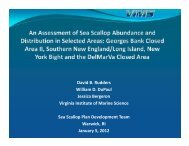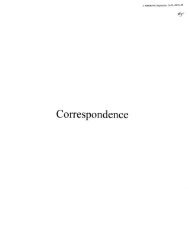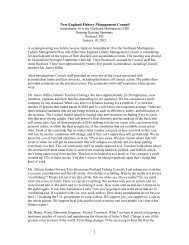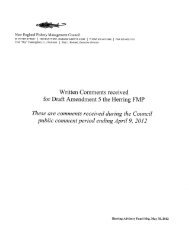Smooth Bottom Net Trawl Fishing Gear Effect on - New England ...
Smooth Bottom Net Trawl Fishing Gear Effect on - New England ...
Smooth Bottom Net Trawl Fishing Gear Effect on - New England ...
Create successful ePaper yourself
Turn your PDF publications into a flip-book with our unique Google optimized e-Paper software.
NOAA/NMFS Unallied Science Project, Cooperative Agreement NA16FL2264 December 2005<br />
<str<strong>on</strong>g>Smooth</str<strong>on</strong>g> <str<strong>on</strong>g>Bottom</str<strong>on</strong>g> <str<strong>on</strong>g>Net</str<strong>on</strong>g> <str<strong>on</strong>g>Trawl</str<strong>on</strong>g> <str<strong>on</strong>g>Fishing</str<strong>on</strong>g> <str<strong>on</strong>g>Gear</str<strong>on</strong>g> <str<strong>on</strong>g>Effect</str<strong>on</strong>g> <strong>on</strong> the Seabed:<br />
Investigati<strong>on</strong> of Temporal and Cumulative <str<strong>on</strong>g>Effect</str<strong>on</strong>g>s BKAM/CR<br />
Gloucester was Pri<strong>on</strong>ospio steenstrupi. A variety of other spi<strong>on</strong>ids were also comm<strong>on</strong> as was<br />
the bivalve Nucula delphinod<strong>on</strong>ta.<br />
The key factor in the Gloucester study is that there has never been any trawling through the sites.<br />
The stati<strong>on</strong>s are too close to shore. The similarity in faunal compositi<strong>on</strong> between the regi<strong>on</strong>s<br />
(2001 report) suggests that trawling activity over the years at Mud Hole and Little Tow, or the<br />
additi<strong>on</strong>al trawling in this study, has not had a significant impact <strong>on</strong> the benthic infauna<br />
collected by these methods. Minor differences in fauna between Mud Hole, Little Tow and<br />
Gloucester sites are due to sediment compositi<strong>on</strong>. Although they have similar silt/clay<br />
percentages, the modal grain size for Gloucester sediments is in the range of fine sands whereas<br />
Mud Hole and Little Tow are mostly medium sands. The study area is also more variable than<br />
Gloucester. The presence of larger particle sizes (medium sand and greater), serve as attachment<br />
sites for epibenthos which might c<strong>on</strong>tribute to the higher species richness seen at Mud Hole and<br />
Little Tow in 2001 (75 – 78 species per grab). Species richness in 2002 at Mud Hole and Little<br />
Tow were not statistically different from that reported for the Gloucester study over many years<br />
(54 – 67 species per grab).<br />
Change in dominance from Pri<strong>on</strong>ospio to Spio from <strong>on</strong>e year to the next and l<strong>on</strong>g-term changes<br />
in species richness and densities over the period 1992 –2002 have been documented in the<br />
MWRA Outfall M<strong>on</strong>itoring Program (Maciolek et al, 2004). In both the MWRA and the<br />
Gloucester outfall studies, the effects of disturbances due to major storms in the early 1990s is<br />
reflected in the benthic data as lowered species richness and densities. Other possible sources of<br />
differences are, variati<strong>on</strong>s in recruitment, l<strong>on</strong>g-term increases in the supply of organic matter to<br />
the benthos, and climatic change related to the North Atlantic Oscillati<strong>on</strong>. The NAO index,<br />
exhibits a multiyear cycle with an average period of 8 – 10 years. Benthic infaunal communities<br />
off the west coast of Sweden have shown a cyclical pattern in abundance and biomass of 7 – 8<br />
years (Tunberg and Nels<strong>on</strong>, 1998). This cycle appears to be related to climatic variability, which<br />
can affect primary productivity. Tunberg and Nels<strong>on</strong> suggest this may be a more important<br />
factor in benthic community structure than anthropogenic factors such as eutrophicati<strong>on</strong>. The<br />
same process could be a factor in Massachusetts and Cape Cod Bays.<br />
3.4.7 Benthic Discussi<strong>on</strong><br />
A large number of studies of the effects of trawling <strong>on</strong> the sea floor have been c<strong>on</strong>ducted, most<br />
of which have dealt with scallop dredges and beam trawls, which are heavier and have a greater<br />
impact <strong>on</strong> the sea floor. C<strong>on</strong>clusi<strong>on</strong>s have varied greatly from significant l<strong>on</strong>g-term impacts to<br />
very minor changes. Major factors c<strong>on</strong>tributing to the degree of impact are:<br />
1) The energy of the envir<strong>on</strong>ment<br />
High-energy envir<strong>on</strong>ments that are subject to frequent physical disturbance are inhabited by<br />
organisms adapted to such stress and the communities are therefore resistant to change and can<br />
recover very quickly (Brylinski et al. 200). Studies in low energy areas have documented faunal<br />
changes that have persisted for varying periods of time (e.g. Kaiser and Spencer, 1996, Sparks-<br />
McC<strong>on</strong>key and Watling 2001)<br />
48







